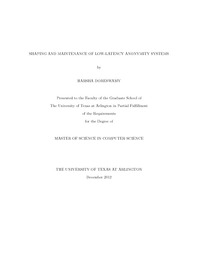| dc.description.abstract | Surveillance of users on the Internet is growing. This makes it increasingly important to protect users' identity when they communicate online, especially for users like journalists, whistleblowers, and military officials. Anonymity systems can conceal users' identities and provide anonymity for their online activities. Low-latency anonymity systems like Tor are designed to provide support for applications like Web browsing, video streaming, and online chat. To make the commutation between source and destination unlinkable, Tor routes all the traffic through three Tor relays, which are spread across the globe. These three relays are usually chosen without considering the delay to get from one to the next. If the relays selected are located too far from each other, it reduces the performance of the system. On the other hand, if we pick the three relays closest to the sender, then it would make it easier for the attacker to identify the sender. In other words, we would lose anonymity. One of biggest challenges in low-latency anonymity systems is maintaining anonymity while improving performance. In this thesis, we try to improve the performance of Tor-like low-latency anonymity systems without sacrificing anonymity. The current version of Tor tries to improve the performance of the system in the relay selection process by biasing clients to select nodes with higher bandwidth. However, the performance gain from bandwidth-based biasing alone is not sufficient for many users. To further increase performance while ensuring strong anonymity properties, we propose to arrange the nodes and links of the network into restricted network topologies, through which anonymized traffic is routed. In building these restricted topologies, we bias the construction process to select lower latency edges to improve performance, while also ensuring that the network's bandwidth capacity is well utilized. We examine two restricted topologies: an expander graph topology and a novel clustering model topology. In the expander graph topology, the system constructs an expander graph with Hamiltonian cycles in which the graph edges are biased towards latency. In the clustering model topology, we cluster the relays based on their bandwidth and construct the graph in two steps. First, the system calculates the number of edges for given node that connects to each cluster based on the ratio of the total number of edges of the cluster to the total number of all edges in the system. Then nodes are selected from these clusters with a bias towards low-latency edges.A key challenge in the deployment of a topology is maintaining the structure and properties of the topology, in spite of churn- nodes joining and leaving the network. We have shown that our topologies, of size 750 nodes, have maintained the structure and properties of the topology for up to 25,000 churn operations without significant degradation to anonymity and performance when compared with the initial topology. We also compare the anonymity and performance of the expander graph versus the clustering model topology on various parameters, such as latency bias, number of hops, and number of nodes joining and leaving. | en_US |


